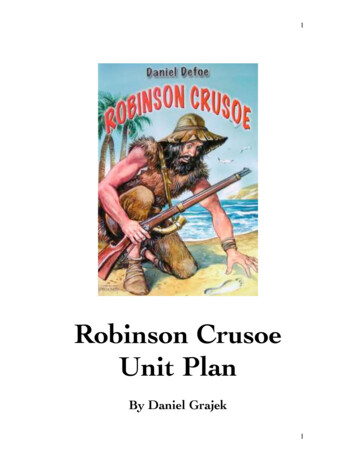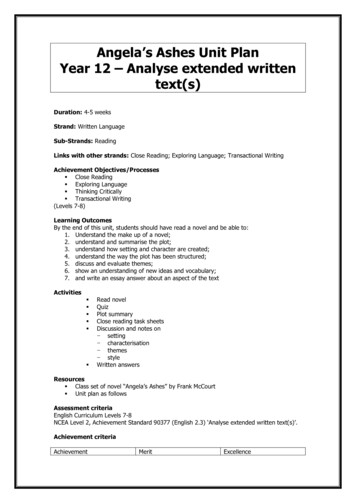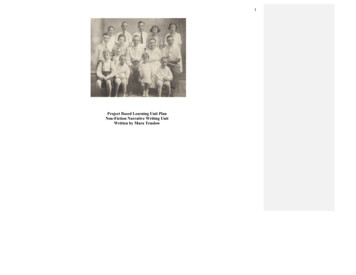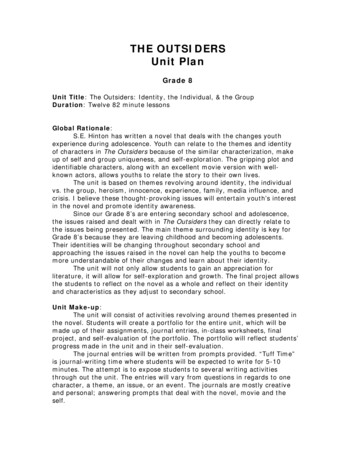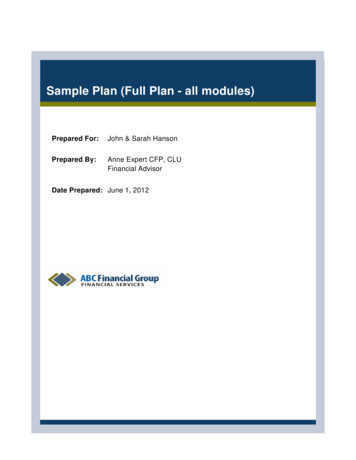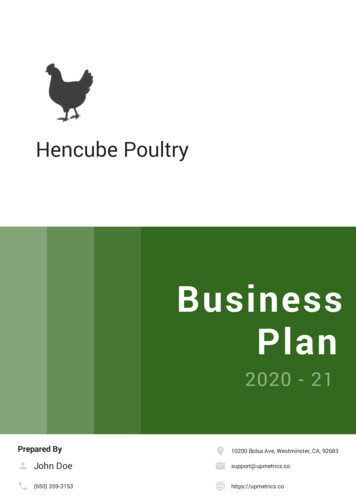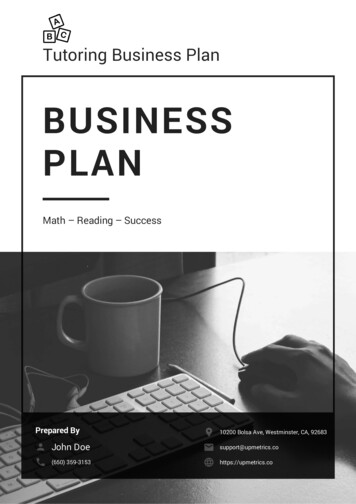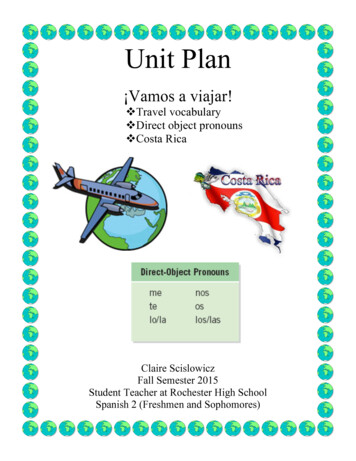
Transcription
Unit Plan¡Vamos a viajar!vTravel vocabularyvDirect object pronounsvCosta RicaClaire ScislowiczFall Semester 2015Student Teacher at Rochester High SchoolSpanish 2 (Freshmen and Sophomores)
2Description of Learning EnvironmentRochester High School is one of three high schools in the Rochester Community Schoolsdistrict, located in Rochester Hills, Michigan. In 2014, the racial profile of students and staff wasout of 1643 individuals total. From this number, 1177 were white, 144 were African American,182 were Asian Hispanic, 77 were American Indian, 1 was Pacific Islander, and 53 were two ormore races. Out of the three high schools in Rochester Community Schools, there is no denyingthat Rochester High contains the highest minority population and diversity. The racial make-updefinitely impacts the level of education. For example, classrooms with a lot of diversity providethe opportunity for students to think critically and discuss distinctive cultures in depth. Also, thepopulation of many minority students can lend itself to teaching tolerance and acceptance of allraces. At Rochester High, the total minority enrollment is 27 percent, which has remained at thislevel for the past 3 years. In addition, the school is home the English language learner's programfor the district for grades 9-12, and has 43 different languages represented. Today, the highschool serves over 80 students who may be scheduled for direct instruction of English and/or foracademic support in English.My student teaching experience has been in Spanish 5AP, Spanish 4, and Spanish 2classes. Therefore, I have taught freshmen, sophomores, juniors, and seniors. The Spanish 5APcurriculum is extraordinary because it focuses on six major world themes: families andcommunities, global challenges, beauty and aesthetics, contemporary life, personal and publicidentities, and science and technology. These themes are extremely relevant for students, whichmake our class discussions and participation very engaging. As far as the Spanish 4 curriculum,so far, I have taught about the Camino de Santiago in Spain, the work world and its vocabulary,reflexive verbs, verbs with prepositions, double object pronouns, and commands. Finally, forSpanish 2, I completed my unit on travel vocabulary, direct object pronouns, and the culture ofCosta Rica.My students at Rochester High have a wide variety of interests, skills, and knowledge.For example, sports, band, music, technology, and travel are all interests that many of mystudents hold. Students in each level started the year with a solid foundation of Spanish from theprevious year. Even my Spanish 2 students retained a lot of basic grammar from Spanish 1. Withrespect to my learners’ current levels of proficiency based on the ACTFL ProficiencyGuidelines, overall I would classify Spanish 5AP students as intermediate low-mid, Spanish 4students as novice high-intermediate low, and Spanish 2 students as novice low-mid.Before I began my travel unit in the Spanish 2 classes, I found out what my students’previous experiences were with the content. Most students had been exposed to direct objectpronouns at the end of Spanish 1, but did not retain the grammatical structures. In relation to thetravel vocabulary, they needed the background information of going to an airport to travel. Somestudents were still confused about the meanings of a boarding pass, itinerary, and customs, so Ithoroughly explained these terms to them at the beginning of the unit to avoid further confusion.A few of my Spanish 2 students have learning disabilities or special needs so I accommodatedfor them by providing multiple modalities for vocabulary and practice sentences. My PowerPointwith travel vocabulary words as well as direct object pronouns included a plethora of visuals andwritten examples for these students.
3Overview of the Instructional Design Title of the unit: ¡Vamos a viajar!Duration of the unit: Two weeksThematic context: Travel vocabulary, direct object pronouns, and Costa Rican cultureACTFL Standards:o Communication Standard 1.1: Students engage in conversations, provide and obtaininformation, express feelings and emotions, and exchange opinions.o Communication Standard 1.2: Students understand and interpret written and spokenlanguage on a variety of topics.o Comparisons Standard 4.1: Students demonstrate understanding of the nature of languagethrough comparisons of the language studied and their owno Comparisons Standard 4.2: Students demonstrate understanding of the concept of culturethrough comparisons of the cultures studied and their owno Culture Standard 2.1: Students demonstrate an understanding of the relationship betweenthe practices and perspectives of the culture studied.o Culture Standard 2.2: Students demonstrate an understanding of the relationship betweenthe products and perspectives of the culture studied.Unit Level Objectives:o Students can use the new vocabulary words to answer personal questions about travel.o Students can evaluate and decipher the meanings of Spanish clues to match vocabularywords with each one.o Students can state the correct vocabulary word based on visuals from the PowerPoint.o Students can listen, watch, and comprehend new vocabulary words in context from anauthentic Costa Rica video.o Students can infer and hypothesize about the culture of Costa Rica (food, music, animals,sports, attractions, etc.).o Students can demonstrate an understanding of Costa Rican culture based on thePowerPoint.o Students can answer comprehension questions about Costa Rica based on theinformation/facts and video from the PowerPoint.o Students can complete a crossword puzzle with Spanish clues based on review from thenew travel vocabulary words.o Students can replace nouns in sentences using DOPs based on the information on thePowerPoint.o Students can say what someone does, what someone is going to do, and what someone isdoing using DOPs and the present tense, simple future, and present progressive.o Students can form responses using DOPs based on visuals from a PowerPoint.o Students can apply the DOP rules to complete a practice worksheet with Spanishsentences in different tenses.Critical thinking skills developed and how: Every Spanish lesson in this unit required criticalthinking skills, whether these skills were figuring out Spanish vocabulary words in anauthentic context, conjugating verb tenses correctly in order to write and speak about thepresent or simple future tense, applying grammar rules in both written and verbal practice, oranswering comprehension questions based on a listening practice. It is so fundamental tovary the types of instruction and assignments to include speaking, listening, reading, andwriting practice. In each lesson, I tried to provide all modes of communication so students
4were able to fine-tune their critical thinking skills. At the end of the unit, students succeededin applying everything they learned about travel vocabulary, direct object pronouns, and theculture of Costa Rica to create Tellagami’s and projects based on trips to Central America.o Student evidence of critical thinking skills:§ Tellagami Examples: https://tellagami.com/gami/S4K2AO/ https://tellagami.com/gami/8IZIOM/ https://tellagami.com/gami/B9MDM9/ https://tellagami.com/gami/QVG1J0/ https://tellagami.com/gami/JNX4KV/§ Central America Project Example: https://prezi.com/wfdhc8omkg05/untitledprezi/?utm campaign share&utm medium copy Authentic texts used in the unit:o Video of a travel agency in Costa Rica from Avancemos 2 textbook videoo Video of “Discover Costa Rica” from YouTube link:https://www.youtube.com/watch?v ZvXNWz6qhfMo Spanish songs using direct object pronouns in the titles:§ Mientras tú me amasJustin Bieber§ Bésalo adiosThe Nylons§ Mientras yo te tengoMark Roach§ Yo la amaba primeroHeartland§ Llámame quizásCarly Rae Jepson§ De toda manera que tú lo quieresJourney§ Ven y tómaloSelena Gomez§ Déjalo irIdina Menzel§ Déjalos ser pequeñosLonestar§ Porque tú me amabasCeline Diono AT&T Spanish Commerical with DOP d-connect-no-lo-crees-spanish Technology integration:o Espon Projectoro PowerPointso Kahoot game with cell phoneso Tellagami Appo Music on YouTube Cultural or interdisciplinary connections made: Students learned all about the culture of CostaRica through a PowerPoint and anecdotes from my CT (since she has traveled there). Theylearned about the location, history, food, president, sports, animals, people, health care,education, and attractions in Costa Rica. The students actually voted to have a quiz on thisinformation because they felt so confident with the material and it was a subject thatinterested a majority of students who typically struggle with grammar or memorization. Inaddition, interdisciplinary connections with geography and world history were made whenwe discussed the location and surrounding areas of Costa Rica as well as its history withother countries.
5Lesson Plan #1 – Travel VocabularyOctober 19, 2015 (5th and 6th hour)Stage 1:A. Context/Theme/Topic/”Big Idea”a. The context of this lesson is for students to learn and become more familiar withtheir new travel vocabulary in the unit. Through reading, speaking, and listeningpractice, students will demonstrate a better understanding of the new vocabularywords in context. In addition, they will watch a short video about travel in CostaRica, which will provide more insight about this culture.B. Objectives:a. Students can use the new vocabulary words to answer personal questions abouttravel.b. Students can evaluate and decipher the meanings of Spanish clues to matchvocabulary words with each one.c. Students can state the correct vocabulary word based on visuals from thePowerPoint.d. Students can listen, watch, and comprehend new vocabulary words in contextfrom an authentic Costa Rica video.C. Grammar/Vocabularya. Grammar: Present tense conjugations for ar/er/ir verbsb. Vocabulary: Travel vocabulary words:i. La agencia de viajes, la/el agente de viajes, el itinerario, hacer la maleta, lamaleta, el boleto, el pasaporte, la identificación, la tarjeta de embarque, elaeropuerto, el/la pasajero/a, hacer cola, la pantalla, pasar por seguridad, elreclamo de equipaje, tomar un taxi, el avión, la parada de autobús, facturarel equipaje, confirmar el vuelo, ir de vacaciones, hacer un viaje, viajar,llamar a, ida y vuelta, traje de baño, abordar, la salida, la llegada, el vuelo,la aduana, el equipaje, la estación de tren, and el/la auxiliar de vueloD. Goal Areas/Standardsa. Communication Standard 1.1: Students engage in conversations, provide andobtain information, express feelings and emotions, and exchange opinions.b. Communication Standard 1.2: Students understand and interpret written andspoken language on a variety of topics.c. Culture Standard 2.1: Students demonstrate an understanding of the relationshipbetween the practices and perspectives of the culture studied.E. Learners:a. I need to have a general idea of how much travel vocabulary (if any) that studentsknow before instructing this lesson.b. Students will need to have background knowledge of general procedures fortraveling, such as traveling to an airport, passing through customs, showing aboarding pass, checking in luggage, etc.c. Students will have already learned how to conjugate normal ar/er/ir verbs in thepresent tense.d. In order to accommodate and differentiate instruction, I will include visuals on thestudents’ vocabulary lists as well as PowerPoint so students have the ability toassociate vocabulary with images. In addition, I will play the Costa Rica video
6two times in order to allow students to first process what is happening and thenanswer the multiple choice comprehension questions.F. Materialsa. White board/markersb. Epson projectorc. PowerPoint with visualsd. Travel worksheet with Spanish cluese. Costa Rica videof. Video multiple choice questionsg. Partner questionsh. Kahoot and cell phonesStage 2:Evidence: Students will grade the Travel worksheet with Spanish clues as well as grade and handin their Costa Rica video multiple-choice questions. These activities act as evidence for studentsto solidify the meanings of the vocabulary words as well as checking for understanding oncultural knowledge of Costa Rica. The partner questions and Kahoot are also evidence forcomprehending the new vocabulary words and answering personal questions about travel.Stage 3:A. Take attendance and take care of administrative duties. Chat with students about howthey are doing, whose parents I saw at conferences last night, and their plans for theweekend. (3 minutes)I always ask my students how they are doing and chat about the weekend because itbuilds deeper connections and relationships as well as creating a safe and comfortablelearning environment.B. Tell students that we are going to start off the hour with a warm-up PowerPoint thatcontains visuals. Explain that once you know which vocabulary word pertains to thevisual, raise your hand and I will call on you to answer. Remind them that they can lookat their vocabulary packets, but try to answer them without them if possible. (10 minutes)By students raising their hands to participate and state the correct answers in the visualwarm-up PowerPoint, I will know that students understand the pictures and know thevocabulary word that corresponds to each.C. Remind students that we started working on a vocabulary worksheet yesterday withSpanish clues on it and have them take it out. Model the first, second, and third exampleswith students. Tell students they can work with a partner for about 5 minutes to figure outthe next couple questions and I will be walking around to assist any students. Explain thatwe will review the answers together afterward. (5 minutes)The vocabulary worksheet is more challenging for my Spanish 2 students because theclues are completely in Spanish, but it is good practice for seeing s
Rochester High School is one of three high schools in the Rochester Community Schools district, located in Rochester Hills, Michigan. In 2014, the racial profile of students and staff was out of 1643 individuals total. From this number, 1177 were white, 144 were African American, 182 were Asian Hispanic, 77 were American Indian, 1 was Pacific .



